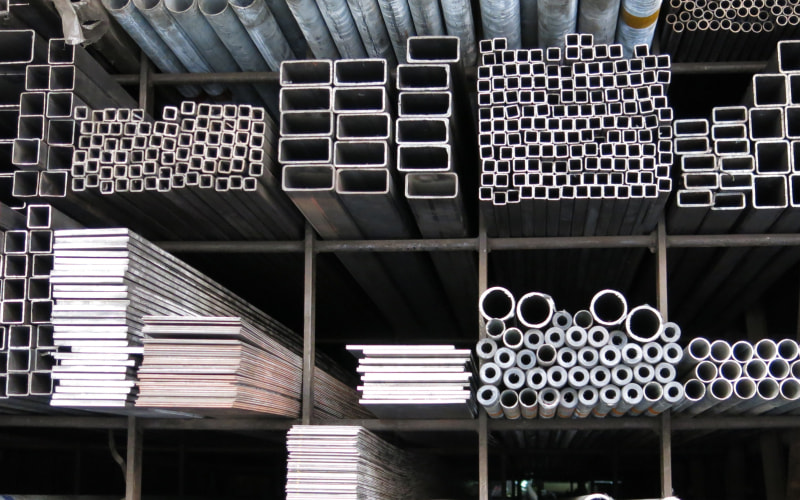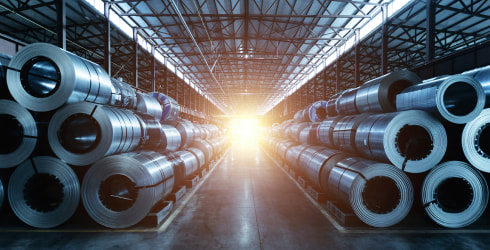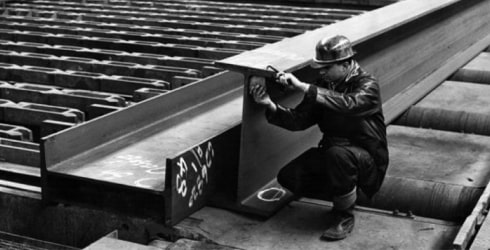Have Specs Ready? Send Us Your RFP for a Fast, Competitive Quote.
Save Big on 36×48 Sheets – Better Yields, Lower Shipping.
Shop Stainless Tubing – Huge Selection, Lower Shipping Rates.


Steel is a lot more complicated than you might guess. Having a basic understanding of steel and its many forms will help you in your metalworking endeavors. The American Iron and Steel Institute (AISI) breaks steel into four types.
A popular acronym to remember the types is CAST: Carbon Alloy Stainless Tool
What are the differences in steel grades?
There are two basic systems used to grade steel based on its make up, treatment, and end-use:
As the name indicates, the main alloying ingredient in this type of steel is carbon.
Carbon steel is highly versatile, and its uses and properties can vary depending on its carbon content. As the carbon content rises, the steel becomes harder and stronger. However, it does become less ductile, more brittle and harder to weld. Also, the higher the carbon, the lower the melting point of the steel.
Carbon steel is further broken down into four groups based on its carbon content: low, medium, high, and ultra-high.
Also called mild steel, low carbon steel contains approximately 0.04–0.3% carbon. Because of this, it is malleable, ductile, tough, and very easy to weld. But it is not readily tempered and has a relatively low tensile strength.
Mild steel is also highly versatile and can be changed based on the project at hand. For example, structural steel often has higher carbon levels with more manganese added for strength. On the other hand, draw quality (DQ) mild steel has lower carbon content and instead has aluminum added.
It is also one of the cheapest forms of steel, making it extremely popular and common.
The carbon content of this metal ranges from 0.31–0.6%. Additionally, medium carbon steel also has a manganese content of 0.6-1.65%. Because of this, this grade has ductility, strength, and good wear resistance. It is stronger and harder than mild steel, but it is more difficult to weld and form.
Medium carbon steel is common in large parts, forged parts, and automotive components. Usually, it is also tempered or heat treated for even more strength.
This material is also known as carbon tool steel, and generally has a range of 0.61-1.5% carbon. High carbon steel is extremely hard and brittle. But because of this it is very difficult to bend, weld, or cut.
Heavy duty springs, edged tools, and high strength wires are frequently made from high carbon steel.
With a carbon content ranging from 1.51-2%, this metal can be heat treated to exceptional hardness. Specialist knives, axles, and punches are typically made from ultra-high carbon steel.
There are some types of steel with more than 2.5% carbon. But these are so challenging to work that they are typically made from powdered metals.
Strictly speaking, every steel is an alloy, but not all steels are called “alloy steels.” However, the term refers to steels that have been alloyed with elements in addition to carbon. The most common elements include manganese, chromium, nickel, silicon, boron molybdenum and vanadium. Less common alloyants include aluminum, cobalt, copper, cerium, niobium, titanium, tungsten, tin, zinc, lead, and zirconium.
Adding other elements to iron and carbon can improve a range of properties. Typically the desired improvements are, strength, hardness, toughness, wear resistance, corrosion resistance, and hardenability.
Alloy steels are broken down into two groups: low-alloy and high-alloy.
With a total of 1-5% alloy content, these are and are easily weldable as long as adequate precautions are taken to avoid defects. Low alloy steels may contain as many as four or five alloys in varying amounts.
High strength low-alloy steel (HSLA) is a type of alloy steel that provides better mechanical properties or greater resistance to corrosion than carbon steel. HSLA steels vary from other steels in that they are not made to meet a specific chemical composition but rather to specific mechanical properties.
The most well-known type of low alloy steel is chromoly steel. This alloy has high amounts of chromium and molybdenum, hence the name. It is a high strength steel that is often mechanically similar to low carbon steels except with significantly more strength. Chromoly, also known as chrome-moly, is commonly used for pins, high strength tubes, molds, tooling, shafts, chain links, and furnace equipment.
Usually more expensive, this type of steel is more specialized. High alloy steel often contains alloy levels in excess of 10%, giving them outstanding properties.
Stainless steel, less commonly known as inox steel, has a minimum of 10.5% chromium. The high chromium and carbon content give stainless steel its iconic corrosion resistance, hardness, and strength.
There are six main types of stainless steel: austenitic, super austenitic, ferritic, duplex steel, martensitic and precipitation-hardening martensitic. These differences are extremely technical and often aren’t very relevant outside of welding. For this reason, we won’t dig into the differences here. If you are curious, we dive into the differences in our blog post about the weldability of stainless steel.
There is also an alloy of stainless steel for any project you could imagine. At present there are over 150 specific alloys of stainless steel. This is why stainless steel is used in everything from medical equipment, and cheap knives at mall kiosks, to spacecraft and airplane hulls.
As the name indicates, tool steel is particularly well-suited for making tools because of its distinctive hardness, resistance to abrasion and ability to hold a cutting edge at elevated temperatures.
The four major alloying elements in tool steel are tungsten, chromium, vanadium and molybdenum. Tool steel is often used by bladesmiths in making knives, axes, swords, and more.
According to AISI and SAE specifications, there are six major types of tool steel based around how they are hardened or what they are used for. These grades are also assigned a letter designation to help clarify what they are.
W – this grade is basically plain high carbon steels that has been water quenched. However, vanadium is also added to increase toughness.
O – oil-hardened
A– air-hardened
D – high chromium, high carbon
These grades have high hardenability and wear resistance, but only average toughness. The O and A grades experience reduced distortion and odds of breakage during quenching compared to water-hardened grades. D grade has 10-13% chromium and retains hardness at high temperatures.
S – this grade is designed to resist shock at very high and low temperatures. They have high impact toughness, but low abrasion resistance.
M – molybdenum based
T– tungsten based
These grades are designed for use in high-speed cutting tools. They have very high strength and hardness even at high temperatures.
H – all of the hot working grades have the letter prefix H, but it is followed by two numbers that provide more details.
H19 – chromium based
H20-39 – tungsten based
H40-59 – molybdenum based
All these grades offer high strength and hardness at prolonged high temperatures.
P – plastic mold steel, this grade is designed for the very specific needs associated with zinc die casting and plastic injection molding dies.
L – low alloy
F – carbon and tungsten based; this grade is water hardenable but more wear resistant than W type.


By any measure, steel is the most used metal in the world. It is highly versatile, strong, and relatively inexpensive to produce. It can be found holding together the tallest skyscrapers or the smallest kitchen cutlery. Steel plays an invaluable role in nearly every aspect of modern society.
Steel is surprisingly ancient. As humans began to use more iron tools and weapons, they discovered that the strengths of iron could be enhanced, and the weaknesses were reduced by alloying it with other ingredients. Somewhere along the line, people stumbled across steel. Steel tools and weapons were found at a 4,000-year-old site in modern turkey. Horace references Romans using steel weapons just over 2,000 years ago, and excavations have shown that the Chinese have been using steel for at least 2,400 years.

In 1855 English chemist Henry Bessemer developed a more efficient method of smelting steel, now known as the Bessemer process. It is essential to the beginning of the modern steel industry. Though the Bessemer process is no longer used, it helped make steel cheap enough to replace iron for the first time in history and was the staple method of steel production until the mid-1900s.
Steel production continues to grow at mind boggling rates. In 2018, it is estimated that the world produced almost 4 TRILLION pounds of steel. China is the world’s largest supplier, with 928.3 million metric tons produced. That is nearly half of the global output of steel. India is a very distant second with 106.5 million metric tons produced. Japan comes in third with 104.3 million metric tons, and the US fourth with 86.7 million metric tons.
While steel production remains massive, many more specialty items are being built these days with specialty grade aluminums, carbon fiber, and plastics. The steel industry is working hard to get back into those fields.
The biggest hurdle for the steel industry is developing new processes for producing steel to reduce and eliminate CO2 emissions. Recycling is critical for the future of metals and steel is no exception. Recycling steel into new and improved projects will not only provide benefits for our environment but may lead to reduced costs and wider availability. While many see recycled steel as “scrap metal” or devalued material, advancements in steel recycling are making drastic economic and environmental improvements.
Furthermore, extreme weather conditions in 2017 and 2018 had major impacts on global steel delivery. Our own parent company thyssenkrupp had major delivery problems because of historically low water levels on the Rhine river. For this reason, many steel giants are looking into reducing their impact and counteracting environmental damage.
Online Metals is the world’s leading eCommerce metal supplier, specializing in small quantity cut-to-size metals and plastics, delivered in a fast and reliable manner.
Since 1998, Online Metals has expanded our catalog to over 85,000 different cut sizes, grown our national footprint to seven pickup locations across the U.S., and continued to improve upon our best-in-class customer experience.
Check out our materials: Alloy Steel, Aluminum, Anodized Aluminum, Beryllium Copper, Brass, Bronze, Carbon Steel, Copper, Cast Iron, Nickel, Nickel Silver, Plastic, Stainless Steel, Titanium, Tool Steel, Unistrut®, Wrought Iron, & Zinc
Shop by shape: Bars, Tubes, Sheets, Plates, and More.
Can't find what you're looking for? Submit a quote or contact our support team.